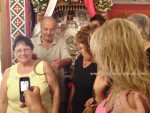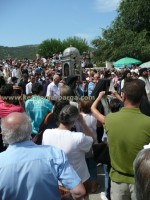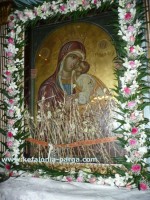Kefalonia ( Cephalonia) in the Orthodox world is very well known fascinating pilgrims with its miracles for many years.
Just a few years ago it was thought that the island of Melita, on which in the first century AD the Apostle Paul landed along with the passengers of the crashed ship, is modern Malta, located in the Mediterranean Sea. After a detailed study of the travel itinerary of the Apostle to Rome, the researchers concluded that Melita mentioned in the Testament is nothing more than the island of Kefalonia ( Cephalonia). The study lasted for several years and scientists from around the world took part in it. Based on the data from oceanography, meteorology and other sciences, they proved that since antiquity the sea routes from Crete to Italy ran through the Ionian Sea via Kefalonia and not Malta. Thus, the Apostle Paul had to land on the island, named after the Greek hero Cephalus, and spent three months there preaching and converting the locals to Christianity. Now Kefalonia ( Cephalonia) can be proud of its involvement in the missionary path of the Great Apostle.
In August, believers and just curious tourists from around the world flock to the island to the feast of the Assumption, which Kefalonia ( Cephalonia) celebrates on August 15. On the feast day, lilies bloom in a small church Gravaliotisa, located in the mountain village of Pastra and dedicated to the Virgin Mary. It would seem that there is nothing special about it. Nothing special indeed, but the white buds swell on completely dry stalks! Five months before the event, on the day of the Annunciation, the parishioners bring fresh lilies to this temple, where they gradually dry up, and already completely dried stalks are left in the church until August. It is on these dry stems, similar to spikelets of wheat, which did not get water until August 15, there are fresh buds. On the feast of the Assumption, after the liturgy the priest gives parishioners miraculously resurrected flowers.
Not far away from Pastra, in the village called Markopoulo, there is another church, well-known throughout the Orthodox world, - Assumption of the Blessed Virgin. In the temple, you will see the icon, which shows the Virgin Mary with small snakes. For a long time, this image has been called Panagia Fedusa that means - Virgin of Snakes. These creatures creep up to the bell tower on the eve of the Assumption. Warden and caretakers collected snakes and place in caskets so that curious visitors, who during the holiday are truly innumerable, would not cause them any harm. In everyday life, these are poisonous snakes, but in the period before the Assumption they can be placed in the hands of everyone and do not sting. The caretakers of the church carry them to the people to touch, lay on the chest or head. I had a chance to hold a snake in my hands - on the creature head, there is a clearly visible cross. The legend says that long ago, when in the place of the bell tower there was a church, the nuns were attacked by pirates. Women begged the Virgin, asking for protection. When the pirates broke into the monastery, instead of the nuns they found ominously hissing snakes, which horrified threw the villains and forced them to retire.
Slightly higher from Markopoulo, there is a settlement called Arginia. During the feast of the Assumption, the snakes appear here as well. Old timers say that little creatures creep up at the same time every year since time immemorial, mysteriously disappearing immediately after the liturgy. Only twice they did not appear – in the year of occupation of the island by the Nazis, who killed many Kefalonians, and in 1953, when a terrible earthquake shook Kefalonia leaving the island almost without a house.
In the church of St. Andrew the Apostle is a small sarcophagus with the foot of the Saint. You can often meet pilgrims from Russia, Ukraine, Poland, Belarus, Slovakia, and Orthodox from other European countries.
We love the monastery Kipouria, surrounded by vineyards on one side and on the other - by the sky- blue sea. The abode is looked after only by one monk. For six decades, this small, friendly, always smiling man lives here on those donations that are allowed by visitors, caring for the grounds and buildings of the monastery. Cosy, cute patio, wreathed with vines laden with colourful pots of flowers planted in them, surrounded by small trees and luxuriant flowering plants creates an atmosphere of quiet joy and peace of mind, reminding the Garden of Eden. No wonder the name of the monastery is consonant with the word "garden". On a huge stone table in the middle of the yard, we place a bottle of red Orxion and dishes. Juicy grapes hanging over the table – is sweet and beloved dessert. Sometimes, the old monk joins us, but usually not for long, he would just smile kindly, try something from our table, and quietly retire.
The monastery is built on a high, steep cliff, against which mighty waves of the Ionian Sea in incredible shade foam fight. A short metal fence separates the courtyard from the abyss at the bottom of which the azure sea rejoices in the gusts of wind. The view is really fascinating and unforgettable. With the dusk, you will realize that it is a true miracle to watch the sunset comfortably sitting in an armchair places along the fence under the cover of the caring monastery. This miracle leaves a warm, gentle trail in your soul. How difficult it is to return to our vain world after a few hours spent in the Kippouria paradise!
The monastery is honoured to be visited by the Kefalonian Metropolitan during the feast of the Exaltation of the Holy Cross of the Lord (September 14) and during the celebration of the Annunciation (March 25). In 1862, the Russian Prince Vladimir Dolgorukov gave the monastery a piece of the Holy Cross. There is also a miraculous icon of the Annunciation, Chrism of Agios Dimitrios (VII century) in an elegant bottle. The caring guardian looks after the monastery relics that found their refuge in the monastery church founded in 1750 and dedicated to the Annunciation and Holy Cross of the Lord. The buildings suffered considerable destruction, especially during the mighty earthquake of 1953. In subsequent years, largely due to the efforts of a solitary monk, the monastery was built.
As you may have guessed, probably the month of August in Kefalonia is mostly full of events and guests. At this time, there is not only the Assumption, which locals call the minor Easter, but also the day of the patron of the island of Saint Gerasimos (Agios Gerasimos)- the founder of the monastic life on Kefalonia (Cephalonia). The monastery named after the Saint is nestled in a valley surrounded by majestic, mountains of smooth outlines near a town called Valsamata.
During the war, not a bomb fell on the monastery, despite the efforts of enemy pilots. Later, they told that during the flights, a threatening elder had appeared to them repeatedly commanding to get out immediately. On the monastery icons, they recognised this heavenly protector of the island, who thwarted deadly weapons to achieve the goal.
Saint Gerasimos was a descendant of a Byzantine noblest kind. He was born in the early 16th century in the Greek city of Corinth. When he was eighteen, the young man went to travel to the holy places visiting Mount Athos, Sinai, and Jerusalem. As a monk in Jerusalem, he served for 12 years in the church of the Holy Sepulchre and was ordained a priest. In 1554, the monk arrived to Kefalonia and spent 6 years in seclusion in a cave located in Argostoli, the island capital. The legend says that St. Gerasimos left the cave at the behest of the Lord to establish a monastery on the island where everyone could come for help and advice. It was a difficult time for Kefalonia when it was ruled by Venetian conquerors. The half-ruined castle of St. George still dominates the island recalling those difficult times.
In memory of his service at the Holy Sepulchre, the future Saint gives the name to the monastery - the New Jerusalem. The monk lived here until 1579 and finished his life path on the day of the Assumption of the Mother of God. Two years after that, the relics of the saint did not undergo decay. Thousands of people received healing from them. Soon, Gerasimos was added to the Saints by the church. During his life, the future Saint had the gift of healing any disease and he does not leave his children without help now. Since then, for more than 400 years not only people from the island are flocking to the monastery but also from around the world to pray to Saint Gerasimos, ask for intercession and thank for his help. We met here Greeks, who arrived from the United States, Australia, England, Germany, and Orthodox Christians from all over Europe. On this day, the valley turns into a giant parking lot, studded with Greek and foreign cars. The monastery hotel does not accommodate pilgrims and they are placed not only in the rooms, but also directly on the floor in the hallway. They sleep in the buses, tents, and just on the ground. The service lasts all night and people stand for hours to venerate the relics of the Saint making their small feat in the name of God and their own salvation.
The service begins on August 14 after the sunset and lasts almost all night. The next day begins with a morning Liturgy. In Greece, the Feast of the Assumption coincides with Armed Forces Day. The Virgin is considered the Patron Saint by the military, so at the service on the day of the Assumption apart from pilgrims the Honour Guard marches to the sound of its best orchestra. All secular sovereignty of Kefalonia also takes part in the feast. Around the monastery, stalls are placed where you can buy church utensils, sweets, and various crafts. The feast of the Assumption blends with the celebration of St. Gerasimos, whose memory day was decided to be celebrated on August 16. The procession with the relics, which are carried upright, moves first to the mighty plane tree that was planted by St. Gerasimos according to the legend. Believers lie in a chain in the path of the ceremony, so that the sarcophagus would be carried over them, praying to their patron for help and believing in healing. Near the giant tree, all read in intoned chorus a prayer to the Saint thanking for patronage and asking for help themselves and yourself and their families. The procession then moves to a small temple where usually relics are positioned.
In the evening, there is a committed procession with the icon of St.Gerasimos along the streets of Argostoli. A tickle procession at first, it turns then into a powerful human river flowing along the waterfront from house to house.
After two days of honouring the Blessed Virgin Mary and St. Gerasimos, the islanders until late at night have fun dancing sirtaki and enjoy lamb with local wine.
Probably all Christians coming to Kefalonia (Cephalonia) are pleasantly amazed of how faith is organically woven into the life of the Greeks. From an early age, from generation to generation they are used to confide all their problems, joys, and sorrows to God asking him for help and thanking for mercy. In the temples, they do not behave like guests but fell themselves at home. It is touching to watch the kids who on entering the church run to venerate the icons and sit on the pulpit listening to the priest. It is common to go to church dressed up especially during major holidays - women are dressed in their best clothes not forgetting about the accessories, make-up, and hairdos, men - in smoking’s and festive costumes. After the long service, they make, right there in the church yard, a feast flavoured with thunderous fireworks, good wine, and revelry.
In all the cafes, shops, bars, taxis, buses, and hotels you will see the icons and a cross. And if you decided to cross yourself according to your habit before eating in the restaurant, it will not cause bewilderment for the locals.
The attitude to the clergymen is completely different compared to Russia - the priest is invited to serve at the local church by the warden of this church. He, I mean the warden, is the master of the church along with other villagers. The serving priest is treated respectfully, but it is seen by a naked eye that he is a guest here, so to say. He was hired to make the sacrament, but the „ball is ruled“ by the warden and villagers.
When you come to the service for the first time, the local parishioners consider you with curiosity, and quite openly, like children. With the understanding that you are not just a tourist, but came to the temple to pray and not just stare, know the service and participate in it, alienation melts, giving way to respect and friendliness. No – there was no trace of malice or ill at all, however, there was some vigilance present: because the temple is a holy place and some tourists do not always behave properly. If Russian pilgrims arrive with their priest – the Greeks will try to help in every way and render any assistance amazed at awe with which Russian pilgrims adhere to the holy relics and faith traditions. I would not decide to presume what is better: a strict adherence to tradition and reverence for the Church or the immediacy and simplicity of relationship to the God and church, faith-based and imbibed with mother`s milk and embedded in the genes as natural as air, without which life is impossible. Let`s hope that the God accepts the one and the other.
To be continued ...
























